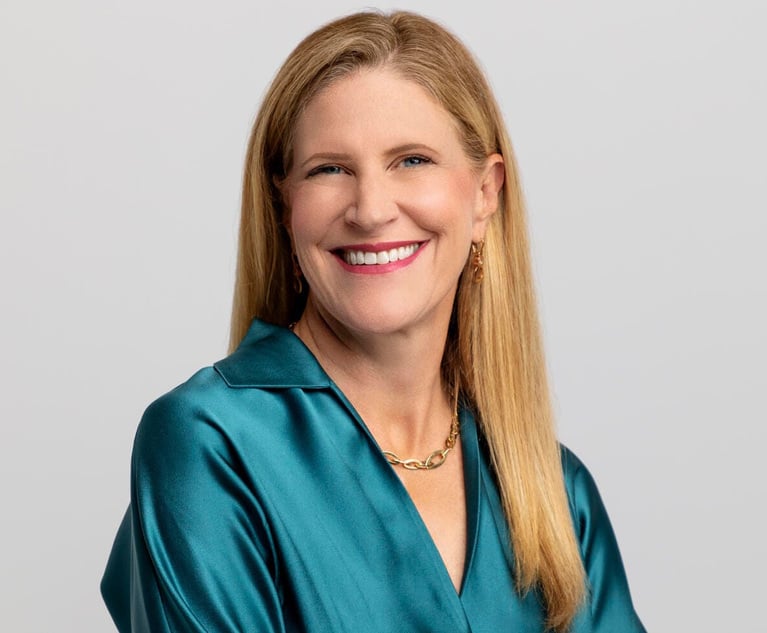Ruling Narrows Executives' Fourth Amendment Rights
Court overrules execs' search-and-seizure challenge.
April 30, 2009 at 08:00 PM
5 minute read
In January 2002, 42 federal agents entered the Westlake Village, Calif., headquarters of SDI Future Health Inc. to execute a search warrant that related to an ongoing investigation of the medical diagnostic test provider's practices. They were looking for evidence of Medicare and tax fraud. But their actions led to a 9th Circuit ruling that could make it easier for such agents to execute corporate searches unchallenged.
Present at the 2002 search were SDI President Todd Kaplan and Vice President Jack Brunk, who both were indicted on related charges in 2005, along with SDI Future Health as a corporate entity. Following the indictment, Kaplan, Brunk and SDI moved to suppress evidence from the 2002 search, and in 2007 the U.S. District Court in Nevada (SDI ran clinics in Nevada) agreed that the search warrant was overbroad.
But on appeal, the government–while it didn't object to the corporate entity's challenge–questioned Kaplan and Brunk's standing under the Fourth Amendment guarantee against unreasonable searches and seizures. In response, the 9th Circuit crafted a new standard for determining when individual corporate executives may challenge a general search of business premises.
What used to be the law is that if corporate executives exercised full access over the building and managerial control over the day-to-day operations of the building, they would have standing personally to challenge the search. “Here, the 9th Circuit said the corporation has standing to challenge the search, but we don't think the corporate executives had standing to challenge the search,” says Jason Skaggs, a solo practitioner who wrote an amicus brief in favor of en banc rehearing of the SDI case on behalf of the Association of Corporate Counsel (ACC) and the U.S. Chamber of Commerce.
The new standard complicates the role of in-house counsel, making it hard, if not impossible, to advise clients targeted by an investigation about their rights in a search situation and throwing a kink into the already thorny counsel-executive relationship.
Iffy Interpretation
The 9th Circuit weighed in on a similar standing issue in the 2005 case United States v. Gonzalez, in which it found that the directors of a business did have standing to challenge a wiretap in a company building. This would appear to apply to United States v. SDI Future Health, but Judge Diarmuid O'Scannlain wrote in her SDI opinion that that ruling was explicitly tied to the nature of the “small, family-run business housing only 25 employees at its peak.” Specifically, she said that the defendants in Gonzalez exercised “managerial control over the day-to-day operations” and exercised “full access to the building.” Kaplan and Brunk made no such claims.
So the court adapted a standard set by the 10th Circuit in 1998 in United States v. Anderson. Under the new standard, executives must establish a “personal connection or exclusive use” of the items in question based on a three-part test (see “Private Property”).
The only exception, the panel said, is for “a small, family-run business over which an individual exercises daily management and control.”
Lingering questions remain. For instance, it's unclear what size company is considered small.
“SDI Future Health is not a small, family-run business, but it's also not a huge Exxon-type corporation, so it seems like beyond the small, family-run business, you're really never going to have standing,” says Mia Haessly, an associate at Miller Chevalier.
The standard also leaves the “family-owned” exception undefined and unexplained, and Skaggs notes it is “kind of created out of nowhere. If the panel decision stands, I guess you wait for the law to be further developed. But as of now I think they've taken a step back in terms of clarity.”
Hands Tied
Beyond the vague standard, the real danger with SDI is the conflict it creates for in-house counsel advising clients.
“It's really difficult for corporate counsel if the rules of constitutional law start to change, with one set for the company and one set for the executives,” says Susan Hackett, general counsel of the ACC.
In situations where the interests of the executives and the corporation diverge, this further complicates the lawyer-executive relationship (see “Tough Calls“). In addition to impacting the defense strategy in current cases, evidence gathered could later be used against the individuals by, for example, third-party plaintiffs in a civil suit–even if the subpoena against the company was previously deemed invalid.
“While everybody recognizes that [in-house counsel] don't represent the individual executives, it's kind of specious to suggest that what happens to the individual executives is of no interest to the company's defense strategy or is of no merit in trying to figure out whether there's a joint defense strategy,” Hackett says.
There are no easy routes for navigating the gray areas the standard creates, but it's clear this is an area to which more attention will be given. The Fourth Amendment questions that SDI presents are still novel in the corporate context, but broader white collar issues are becoming a larger focus for in-house counsel in this decade of corporate scandals.
“While they're not the ones representing executives who are targeted,” Hackett says, “[in-house counsel] have to figure out whether the corporation is going to divorce itself in some way from the executive, or whether the executive was acting within the scope of authority, and they're going to defend that executive action.”
This content has been archived. It is available through our partners, LexisNexis® and Bloomberg Law.
To view this content, please continue to their sites.
Not a Lexis Subscriber?
Subscribe Now
Not a Bloomberg Law Subscriber?
Subscribe Now
NOT FOR REPRINT
© 2025 ALM Global, LLC, All Rights Reserved. Request academic re-use from www.copyright.com. All other uses, submit a request to [email protected]. For more information visit Asset & Logo Licensing.
You Might Like
View All
What to Know About the New 'Overlapping Directorship' Antitrust Development
4 minute read
Tesla, Musk Appeal Chancery Compensation Case to Delaware Supreme Court
2 minute read
Ex-Marathon General Counsel Takes Legal Reins of Another Energy Company

Former Capital One Deputy GC Takes Legal Reins of AIG Spinoff
Trending Stories
- 1'David and Goliath' Dispute Between Software Developers Ends in $24M Settlement
- 2Supreme Court Takes Up the Corporate Transparency Act: Recent Litigation and Potential Next Steps
- 3Brogdon: The Final Nail in Corbin’s Coffin in Premises Cases
- 4What to Know About the New 'Overlapping Directorship' Antitrust Development
- 5'Quiet, Appropriate End:' NY Court of Appeals Formally Removes Erin Gall From Bench
Who Got The Work
Michael G. Bongiorno, Andrew Scott Dulberg and Elizabeth E. Driscoll from Wilmer Cutler Pickering Hale and Dorr have stepped in to represent Symbotic Inc., an A.I.-enabled technology platform that focuses on increasing supply chain efficiency, and other defendants in a pending shareholder derivative lawsuit. The case, filed Oct. 2 in Massachusetts District Court by the Brown Law Firm on behalf of Stephen Austen, accuses certain officers and directors of misleading investors in regard to Symbotic's potential for margin growth by failing to disclose that the company was not equipped to timely deploy its systems or manage expenses through project delays. The case, assigned to U.S. District Judge Nathaniel M. Gorton, is 1:24-cv-12522, Austen v. Cohen et al.
Who Got The Work
Edmund Polubinski and Marie Killmond of Davis Polk & Wardwell have entered appearances for data platform software development company MongoDB and other defendants in a pending shareholder derivative lawsuit. The action, filed Oct. 7 in New York Southern District Court by the Brown Law Firm, accuses the company's directors and/or officers of falsely expressing confidence in the company’s restructuring of its sales incentive plan and downplaying the severity of decreases in its upfront commitments. The case is 1:24-cv-07594, Roy v. Ittycheria et al.
Who Got The Work
Amy O. Bruchs and Kurt F. Ellison of Michael Best & Friedrich have entered appearances for Epic Systems Corp. in a pending employment discrimination lawsuit. The suit was filed Sept. 7 in Wisconsin Western District Court by Levine Eisberner LLC and Siri & Glimstad on behalf of a project manager who claims that he was wrongfully terminated after applying for a religious exemption to the defendant's COVID-19 vaccine mandate. The case, assigned to U.S. Magistrate Judge Anita Marie Boor, is 3:24-cv-00630, Secker, Nathan v. Epic Systems Corporation.
Who Got The Work
David X. Sullivan, Thomas J. Finn and Gregory A. Hall from McCarter & English have entered appearances for Sunrun Installation Services in a pending civil rights lawsuit. The complaint was filed Sept. 4 in Connecticut District Court by attorney Robert M. Berke on behalf of former employee George Edward Steins, who was arrested and charged with employing an unregistered home improvement salesperson. The complaint alleges that had Sunrun informed the Connecticut Department of Consumer Protection that the plaintiff's employment had ended in 2017 and that he no longer held Sunrun's home improvement contractor license, he would not have been hit with charges, which were dismissed in May 2024. The case, assigned to U.S. District Judge Jeffrey A. Meyer, is 3:24-cv-01423, Steins v. Sunrun, Inc. et al.
Who Got The Work
Greenberg Traurig shareholder Joshua L. Raskin has entered an appearance for boohoo.com UK Ltd. in a pending patent infringement lawsuit. The suit, filed Sept. 3 in Texas Eastern District Court by Rozier Hardt McDonough on behalf of Alto Dynamics, asserts five patents related to an online shopping platform. The case, assigned to U.S. District Judge Rodney Gilstrap, is 2:24-cv-00719, Alto Dynamics, LLC v. boohoo.com UK Limited.
Featured Firms
Law Offices of Gary Martin Hays & Associates, P.C.
(470) 294-1674
Law Offices of Mark E. Salomone
(857) 444-6468
Smith & Hassler
(713) 739-1250






